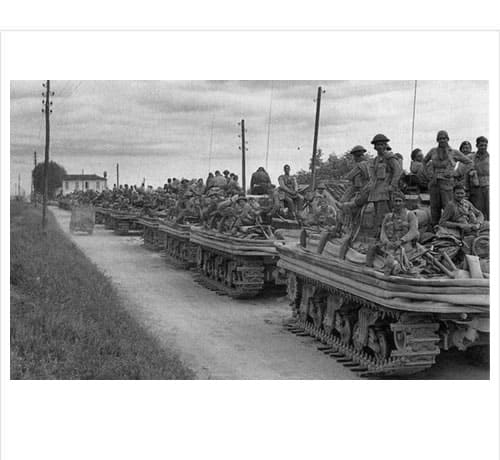The image shows Sherman DD Tanks of ‘B’ Squadron, 7th Hussars, 30th April 1945, carrying men of 55 Mahratta Light Infantry (8th Indian Division)
In late April 1945, the 7th Queen’s Own Hussars were supporting the crossing of the Po on a wide frontage, playing a leading part on the whole front of the 8th Army.
Lt-Col Congreve and his RHQ directed the technical side of the river crossing on one sector of the front. ‘A’ Squadron, (Commanded by Major M. V. Argyle), was placed under command of the 56th (London) Division, ‘B’ Squadron went to the 8th Indian Division and ‘C’ to 6th Armoured Division, with a troop of ‘C’ also being detached to 2nd New Zealand Division. The Squadrons did not meet again until the pursuit was over. Within a week the regiment was spread around the head of the Adriatic with its extremities 150 miles apart.
‘A’ Squadron, 7th Hussars, (by now re-equipped with Sherman DD tanks) crossed the Po on the evening of 25th April, with no casualties, but one tank hit an underwater obstruction and sank like a stone. 2/6th Queen’s infantry then crossed in Fantails and after minimum resistance, a bridge over the Tartaro was captured, and then another over the Adige at Anguillara. Elsewhere, the village of Mardimago needed combined Queens and Hussars to clear it.
On the 27th April 1945 at 11 pm at Pioppe, five DD Shermans swam the River Adige, followed by 2/7th Queens in Fantails and the hot pursuit continued, which meant that by 9 pm on 28th April the 2/7th Queens and 7th Hussars column was held up near the canal bridge at Brenta only three miles from the great Venice lagoon.
The next day at the canal bridge at Dolo the column met the New Zealanders arriving from Padua. Then a 30-minute argument ensued, about who should lead into Venice? The New Zealanders had maps of the area and also had wireless contact with Divisional, and higher, formations, so claimed the privilege. Both columns set off and at Mestre, the New Zealanders kept straight ahead, while the Queens and Hussars turned off down the causeway into Venice.
The port authorities surrendered and ‘A’ Squadron moved into leaguer in the docks area. An hour later ‘B’ Squadron arrived having supported the Royal Fusiliers and 5th Gurkhas across the same three rivers starting from near Ferrara to Canale Bianco and Roverdicre. Another seventeen DD Shermans loaded up a company of 5/5 Mahratta Light Infantry (8th Indian Division) and set off along Route 16 to Battaglia, sped through Padua along the autostrada into Venice, there they harboured in the Piazzale Roma instead of the docks. ‘C’ Squadron (commanded by Major Marcus Fox) who initially supported the 3rd Grenadier Guards, then the Welsh Guards, a New Zealand formation and 2nd Rifle Brigade, (of 61st Brigade, 6th Armoured Division) were held back after the Po and Adige crossing, as the New Zealanders had road priority. However, 4th Troop of ‘C’ Squadron allied to the 20th New Zealand Armoured Regiment drove via Padua, Musile and Route 14 straight for Trieste, where having covered 97 miles in one day, they entered the city and met a patrol of the Long Range Desert Group there.
Of the fifty-seven 7th Hussar DD tanks that had set off and eighteen were still fit for swimming at the end (Venice lagoon or Trieste). All of the rest except one were recoverable. By the time the capitulation was signed 7th Hussars were concentrated at Mestre. The 7th Hussars were ‘joint first’ into Venice and Trieste and with that their war came to an end.


